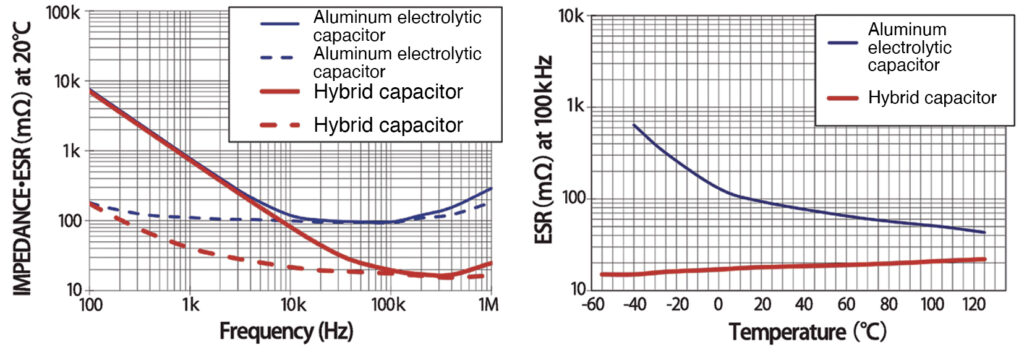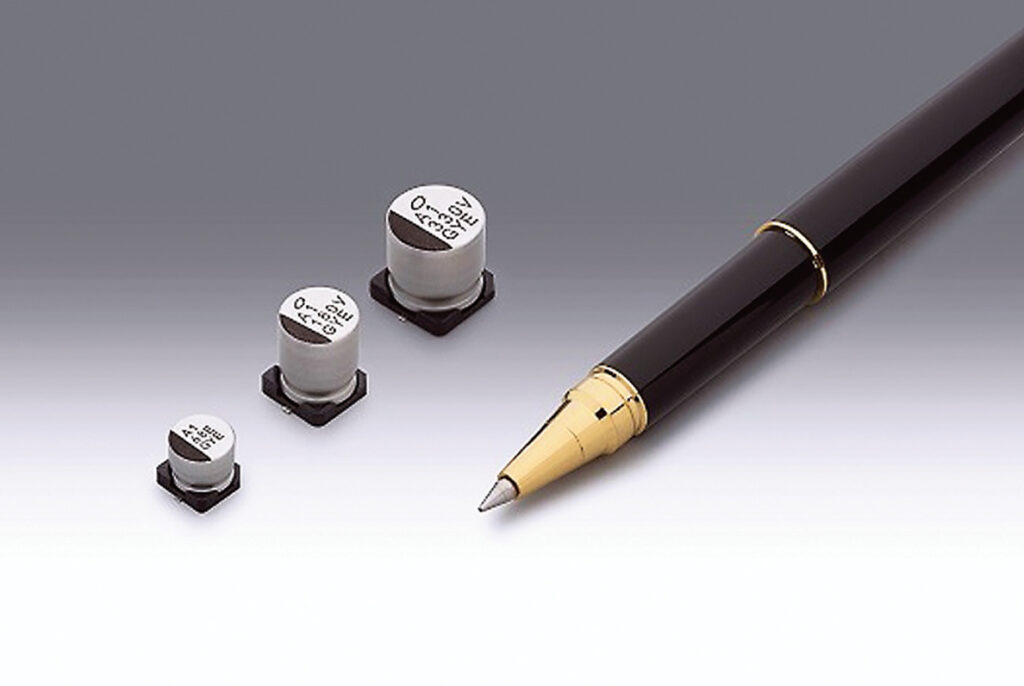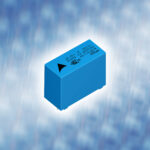ASIA ELECTRONICS INDUSTRYYOUR WINDOW TO SMART MANUFACTURING
Conductive Polymer Hybrid Capacitors Rally with Car Trends
In recent years, the environment surrounding automobiles has changed significantly. The shift from internal combustion engines to hybrid vehicles (HVs) and then to electric vehicles (EVs) has been progressing for the purpose of solving environmental threats. In addition, the development of safety technologies related to advanced driver assistance systems (ADAS) and of automobiles equipped with autonomous driving functions has been accelerating. Moreover, the development of automatic braking, image recognition, and sensor-related equipment, which are indispensable for these functions, is also in progress. These factors pull up the demand for automotive electronic components.
Capacitors featuring higher reliability are also in demand for automotive applications. They are also required to be compatible with high-temperature and harsh environments and to have small size, high capacity, and low equivalent series resistance (ESR) performance.
The latest technological trends of conductive polymer hybrid aluminum electrolytic capacitors, which are most suitable for automotive applications, are discussed in this article from Nichicon Corporation. Also, the development of the company’s actual products is briefly discussed.
Advantages of Conductive Polymer Hybrid Capacitors
In a general aluminum electrolytic capacitor, an electrolytic solution is impregnated as an electrolyte in an element. In the element, an anode foil and a cathode foil, both being covered with a dielectric film, are wound up together with a separator. In a conductive polymer aluminum solid electrolytic capacitor, which uses a conductive polymer as an electrolyte, the current is carried by electrons. This makes the conductivity very high – about 10,000 times higher than that of electrolytes of the ionic conduction. Therefore, it is possible to significantly reduce ESR.
On the other hand, a general aluminum electrolytic capacitor repairs the defective part of a dielectric film caused by heat or by an external factor with an electrolytic solution. Meanwhile, the repair performance of conductive polymer is poor compared to electrolytic solutions. Therefore, the actual value of leakage current is relatively high in the conductive polymer aluminum solid electrolytic capacitor. In conductive polymer hybrid aluminum electrolytic capacitors, a conductive polymer and an appropriate electrolytic solution are used as the electrolyte. In this composition, it is possible to realize low leakage current comparable to that of a general aluminum electrolytic capacitor without impairing the performance of the conductive polymer.
As a result, the conductive polymer hybrid aluminum electrolytic capacitor has excellent frequency characteristics. With this capacitor, the ESR change is small even in the low temperature range, which is important for automotive applications. Stable performance can be maintained even in harsh environments, such as in cold regions and highlands (Fig. 1). Long term changes in ESR are also smaller than those of general aluminum electrolytic capacitors. Electrical stability can be maintained even when being used for a long time in a high temperature environment. Therefore, the guaranteed value can be made higher for the allowable ripple current.

The conductive polymer hybrid aluminum electrolytic capacitor has merits of both a general aluminum electrolytic capacitor and a conductive polymer aluminum solid electrolytic capacitor. Its demand is growing mainly for electric power steering (EPS) used at high currents and for automotive motor control circuits for mild hybrids with 48V power supply and for pump drive.
Future Outlook
Conductive polymer hybrid aluminum electrolytic capacitors have excellent features, such as low ESR, high ripple current, wide temperature compatibility, and high durability. Therefore, it is expected that demand will increase not only for automobile applications, but also for consumer and industrial machinery applications. Especially in automobile applications, it is expected that various sensors will be upgraded with the development of safety functions and autonomous driving, bringing the electrification to a new level.
As the number of capacitors mounted increases, expectations for high-performance capacitors will increase further in the future.
The company will also accelerate the development of capacitors for longer life, higher heat resistance, higher ripple, and higher capacity.
Lineup of Conductive Polymer Hybrid Capacitors
GYC Series
The GYA Series conductive polymer hybrid aluminum electrolytic capacitors with guaranteed 125°C for 4,000 hours started mass production in 2017. In response to the market demand for the increase of temperature and ripples, the GYC Series was added in the lineup in 2019. It was developed as a high-temperature product with guaranteed 135°C and 4,000 hours, and mass production has started.
Recently, products with size φ10 × 12.5L have been newly added to the series consisting of those with sizes φ6.3 × 5.8L, φ6.3 × 7.7L, φ8 × 10L, φ10 × 10L. As a result, the maximum ripple current supported has increased up to 1.3 times higher than before.
GYE Series
In some applications, the allowable ripple current becomes a bottleneck when selecting their number for general aluminum electrolytic capacitors. In such applications, however, significant reduction is possible in the size and the number when they are replaced with the conductive polymer hybrid aluminum electrolytic capacitors. This reflects an increasing need for higher capacity.

Recently, the GYE Series, which is one rank higher in capacity than the GYA Series, has been developed as a 125° high-capacity product. The GYE Series has achieved high capacity through the adoption of a high-capacity anode foil and the optimization of the conductive polymer material and electrolyte. The rated ripple current is about 1.2 times higher than that of the GYA Series. The system list of GYE Series is shown in Table 1.

The products with sizes φ6.3 × 7.7L, φ8 × 10L, and φ10 × 10L of each series support also vibration-resistant structures with guaranteed acceleration of 30G. Table 2 shows the outline of the series of conductive polymer hybrid aluminum electrolytic capacitors produced by the company.

About This Article:
Nichicon Corporation provided the contents of the article.




